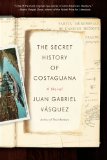Summary | Excerpt | Reviews | Beyond the Book | Read-Alikes | Genres & Themes | Author Bio

Critics' Opinion:
Readers' Opinion:
First Published:
Jun 2011, 304 pages
Paperback:
Aug 2012, 320 pages
 Book Reviewed by:
Book Reviewed by:
Sarah Sacha Dollacker
Buy This Book
This article relates to The Secret History of Costaguana
Juan Gabriel Vásquez's novel, The Secret History of Costagauna, centers on the making of the Panama Canal. Constructed between 1904 and 1914, the Panama Canal is a vital shipping route that connects the Atlantic and Pacific Oceans.
 Though it only took ten years to construct the current canal, the idea for a waterway connecting the two oceans dates back to the 16th century. The route around the horn of South America was long, arduous, and costly. If it were possible to create a water route over the thin isthmus between North and South America, a great deal of money and time could be saved. There were discussions and some rudimentary attempts, but construction of a canal did not start in earnest until 1881 under the direction of Ferdinand de Lesseps when the French decided to create an all-water route, i.e., a sea-level canal without locks, in Columbia's province of Panama.
Though it only took ten years to construct the current canal, the idea for a waterway connecting the two oceans dates back to the 16th century. The route around the horn of South America was long, arduous, and costly. If it were possible to create a water route over the thin isthmus between North and South America, a great deal of money and time could be saved. There were discussions and some rudimentary attempts, but construction of a canal did not start in earnest until 1881 under the direction of Ferdinand de Lesseps when the French decided to create an all-water route, i.e., a sea-level canal without locks, in Columbia's province of Panama.
The French were encouraged in their idea for a sea-level canal by their success in creating the Suez Canal, which connected the Red Sea to the Mediterranean Sea. At approximately 102 miles long, it had been a much larger project than the Panama Canal, only 48 miles long. However, despite best efforts, poor planning and disease made the project challenging from the start. Yellow fever and malaria were rampant, and it was soon difficult to maintain a proper work force. With an estimated 25,000 deaths during this period of French oversight, the project was abandoned in 1889 by de Lesseps, and, according to the Panama Canal Museum, in 1894 Philippe Bunau-Varilla offered to sell the company's assests to the US for $109 million and later reduced the price to $40 million.
Despite France's failure, there was still great interest in a Panamanian canal, and in 1902 the United States Senate voted to pursue options in constructing one. In 1903 the Hay-Herrán Treaty was signed between the United States and Colombia granting the United States a renewable lease "in perpetuity" on the land to be used for the canal. It was ratified by the United States but not by Colombia, and it was soon feared that a revolt might erupt. It was hoped that the United States would support the revolt should one break out, but President Theodore Roosevelt changed tactics by promising support if Panama were to separate from Colombia. Colombian troops were unable to squash Panama's efforts to create a sovereign state because they could not reach it: United States warships blocked sea-lanes, and dense jungles made traveling overland to the site impossible.
Panama achieved independence in November 1903 and was quickly recognized by the United States. The Hay-Bunau-Varilla Treaty was soon signed, allowing the United States to build and administer the Panama Canal indefinitely. The fact that Bunau-Varilla was actually a French citizen, even though he acted as Panama's ambassador, would later cause strained diplomatic relations between Panama and the United States. The United States began construction in 1904 after purchasing the French equipment and excavations for $40 million and chose to construct a system of locks in the canal to lift and assist traveling ships, a stark deviation from the French plan of an all-water route, and successfully completed the project ten years later.
Watch the video below for classic footage and a narrated chronology of the American construction of the Panama Canal.
Filed under Places, Cultures & Identities
![]() This "beyond the book article" relates to The Secret History of Costaguana. It originally ran in July 2011 and has been updated for the
August 2012 paperback edition.
Go to magazine.
This "beyond the book article" relates to The Secret History of Costaguana. It originally ran in July 2011 and has been updated for the
August 2012 paperback edition.
Go to magazine.





The House on Biscayne Bay
by Chanel Cleeton
As death stalks a gothic mansion in Miami, the lives of two women intertwine as the past and present collide.

The Flower Sisters
by Michelle Collins Anderson
From the new Fannie Flagg of the Ozarks, a richly-woven story of family, forgiveness, and reinvention.

The Funeral Cryer by Wenyan Lu
Debut novelist Wenyan Lu brings us this witty yet profound story about one woman's midlife reawakening in contemporary rural China.
Your guide toexceptional books
BookBrowse seeks out and recommends the best in contemporary fiction and nonfiction—books that not only engage and entertain but also deepen our understanding of ourselves and the world around us.